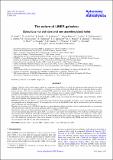Files in this item
The nature of LINER galaxies : ubiquitous hot old stars and rare accreting black holes
Item metadata
| dc.contributor.author | Singh, R. | |
| dc.contributor.author | van de Ven, G. | |
| dc.contributor.author | Jahnke, K. | |
| dc.contributor.author | Lyubenova, M. | |
| dc.contributor.author | Falcón-Barroso, J. | |
| dc.contributor.author | Alves, J. | |
| dc.contributor.author | Cid Fernandes, R. | |
| dc.contributor.author | Galbany, L. | |
| dc.contributor.author | García-Benito, R. | |
| dc.contributor.author | Husemann, B. | |
| dc.contributor.author | Kennicutt, R. C. | |
| dc.contributor.author | Marino, R. A. | |
| dc.contributor.author | Márquez, I. | |
| dc.contributor.author | Masegosa, J. | |
| dc.contributor.author | Mast, D. | |
| dc.contributor.author | Pasquali, A. | |
| dc.contributor.author | Sánchez, S. F. | |
| dc.contributor.author | Walcher, J. | |
| dc.contributor.author | Wild, V. | |
| dc.contributor.author | Wisotzki, L. | |
| dc.contributor.author | Ziegler, B. | |
| dc.date.accessioned | 2014-09-19T11:01:02Z | |
| dc.date.available | 2014-09-19T11:01:02Z | |
| dc.date.issued | 2013-10-01 | |
| dc.identifier | 119002713 | |
| dc.identifier | eeda6b3c-d9a3-47b8-bf41-6a29a2eb1706 | |
| dc.identifier | 84884994883 | |
| dc.identifier.citation | Singh , R , van de Ven , G , Jahnke , K , Lyubenova , M , Falcón-Barroso , J , Alves , J , Cid Fernandes , R , Galbany , L , García-Benito , R , Husemann , B , Kennicutt , R C , Marino , R A , Márquez , I , Masegosa , J , Mast , D , Pasquali , A , Sánchez , S F , Walcher , J , Wild , V , Wisotzki , L & Ziegler , B 2013 , ' The nature of LINER galaxies : ubiquitous hot old stars and rare accreting black holes ' , Astronomy & Astrophysics , vol. 558 , A43 . https://doi.org/10.1051/0004-6361/201322062 | en |
| dc.identifier.issn | 0004-6361 | |
| dc.identifier.other | BibCode: 2013A&A...558A..43S | |
| dc.identifier.uri | https://hdl.handle.net/10023/5456 | |
| dc.description | R.S. acknowledges support by the IMPRS for Astronomy & Cosmic Physics at the University of Heidelberg. K.J. is supported by the Emmy Noether-Programme of the German Science Foundation DFG under grant Ja 1114/3-2 and the German Space Agency DLR. G.v.d.V. and J.F.-B. acknowledge the DAGAL network from the People Programme (Marie Curie Actions) of the European Union’s Seventh Framework Programme FP7/2007-2013/ under REA grant agreement number PITN-GA-2011-289313. J.F.-B. further acknowledges financial support from the Ramón y Cajal Program and grant AYA2010-21322-C03-02 from the Spanish Ministry of Economy and Competitiveness (MINECO). V.W. acknowledges support from the ERC Starting Grant SEDmorph. R. A. Marino was also funded by the spanish programme of International Campus of Excellence Moncloa (CEI). | en |
| dc.description.abstract | Context. Galaxies, which often contain ionised gas, sometimes also exhibit a so-called low-ionisation nuclear emission line region (LINER). For 30 years, this was attributed to a central mass-accreting supermassive black hole (more commonly known as active galactic nucleus, AGN) of low luminosity, making LINER galaxies the largest AGN sub-population, which dominate in numbers over higher luminosity Seyfert galaxies and quasars. This, however, poses a serious problem. While the inferred energy balance is plausible, many LINERs clearly do not contain any other independent signatures of an AGN. Aims. Using integral field spectroscopic data from the CALIFA survey, we compare the observed radial surface brightness profiles with what is expected from illumination by an AGN. Methods. Essential for this analysis is a proper extraction of emission lines, especially weak lines, such as Balmer Hβ lines, which are superposed on an absorption trough. To accomplish this, we use the GANDALF code, which simultaneously fits the underlying stellar continuum and emission lines. Results. For 48 galaxies with LINER-like emission, we show that the radial emission-line surface brightness profiles are inconsistent with ionisation by a central point-source and hence cannot be due to an AGN alone. Conclusions. The most probable explanation for the excess LINER-like emission is ionisation by evolved stars during the short but very hot and energetic phase known as post-AGB. This leads us to an entirely new interpretation. Post-AGB stars are ubiquitous and their ionising effect should be potentially observable in every galaxy with the gas present and with stars older than ~1 Gyr unless a stronger radiation field from young hot stars or an AGN outshines them. This means that galaxies with LINER-like emission are not a class defined by a property but rather by the absence of a property. It also explains why LINER emission is observed mostly in massive galaxies with old stars and little star formation. | |
| dc.format.extent | 8 | |
| dc.format.extent | 3201233 | |
| dc.language.iso | eng | |
| dc.relation.ispartof | Astronomy & Astrophysics | en |
| dc.subject | Galaxies: active | en |
| dc.subject | Galaxies: ISM | en |
| dc.subject | Galaxies: nuclei | en |
| dc.subject | Stars: AGB and post-AGB | en |
| dc.subject | QB Astronomy | en |
| dc.subject | QC Physics | en |
| dc.subject.lcc | QB | en |
| dc.subject.lcc | QC | en |
| dc.title | The nature of LINER galaxies : ubiquitous hot old stars and rare accreting black holes | en |
| dc.type | Journal article | en |
| dc.contributor.sponsor | European Research Council | en |
| dc.contributor.institution | University of St Andrews. School of Physics and Astronomy | en |
| dc.identifier.doi | https://doi.org/10.1051/0004-6361/201322062 | |
| dc.description.status | Peer reviewed | en |
| dc.identifier.grantnumber | ERC-2012-StG-20111012 | en |
This item appears in the following Collection(s)
Items in the St Andrews Research Repository are protected by copyright, with all rights reserved, unless otherwise indicated.

